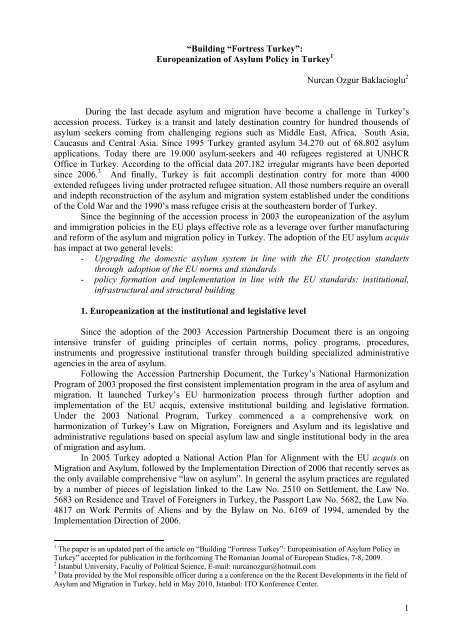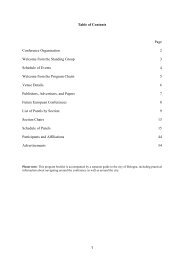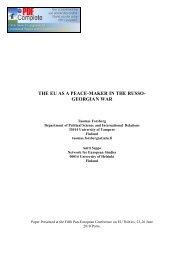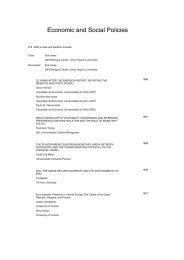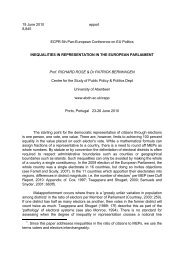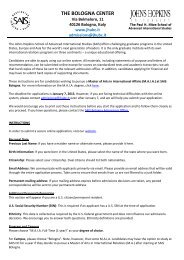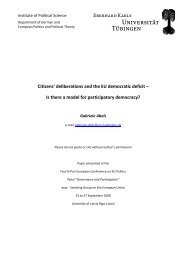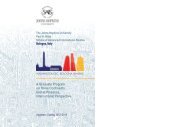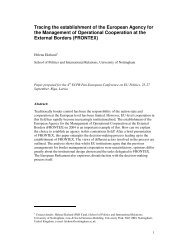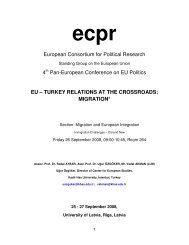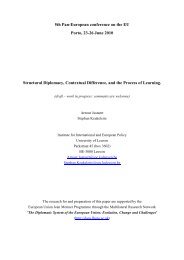1 “Building “Fortress Turkey”: Europeanization of Asylum Policy in ...
1 “Building “Fortress Turkey”: Europeanization of Asylum Policy in ...
1 “Building “Fortress Turkey”: Europeanization of Asylum Policy in ...
Create successful ePaper yourself
Turn your PDF publications into a flip-book with our unique Google optimized e-Paper software.
<strong>“Build<strong>in</strong>g</strong> <strong>“Fortress</strong> <strong>Turkey”</strong>:<br />
<strong>Europeanization</strong> <strong>of</strong> <strong>Asylum</strong> <strong>Policy</strong> <strong>in</strong> Turkey 1<br />
Nurcan Ozgur Baklacioglu 2<br />
Dur<strong>in</strong>g the last decade asylum and migration have become a challenge <strong>in</strong> Turkey’s<br />
accession process. Turkey is a transit and lately dest<strong>in</strong>ation country for hundred thousends <strong>of</strong><br />
asylum seekers com<strong>in</strong>g from challeng<strong>in</strong>g regions such as Middle East, Africa, South Asia,<br />
Caucasus and Central Asia. S<strong>in</strong>ce 1995 Turkey granted asylum 34.270 out <strong>of</strong> 68.802 asylum<br />
applications. Today there are 19.000 asylum-seekers and 40 refugees registered at UNHCR<br />
Office <strong>in</strong> Turkey. Accord<strong>in</strong>g to the <strong>of</strong>ficial data 207.182 irregular migrants have been deported<br />
s<strong>in</strong>ce 2006. 3 And f<strong>in</strong>ally, Turkey is fait accompli dest<strong>in</strong>ation contry for more than 4000<br />
extended refugees liv<strong>in</strong>g under protracted refugee situation. All those numbers require an overall<br />
and <strong>in</strong>depth reconstruction <strong>of</strong> the asylum and migration system established under the conditions<br />
<strong>of</strong> the Cold War and the 1990’s mass refugee crisis at the southeastern border <strong>of</strong> Turkey.<br />
S<strong>in</strong>ce the beg<strong>in</strong>n<strong>in</strong>g <strong>of</strong> the accession process <strong>in</strong> 2003 the europeanization <strong>of</strong> the asylum<br />
and immigration policies <strong>in</strong> the EU plays effective role as a leverage over further manufactur<strong>in</strong>g<br />
and reform <strong>of</strong> the asylum and migration policy <strong>in</strong> Turkey. The adoption <strong>of</strong> the EU asylum acquis<br />
has impact at two general levels:<br />
- Upgrad<strong>in</strong>g the domestic asylum system <strong>in</strong> l<strong>in</strong>e with the EU protection standarts<br />
through adoption <strong>of</strong> the EU norms and standards<br />
- policy formation and implementation <strong>in</strong> l<strong>in</strong>e with the EU standards: <strong>in</strong>stitutional,<br />
<strong>in</strong>frastructural and structural build<strong>in</strong>g<br />
1. <strong>Europeanization</strong> at the <strong>in</strong>stitutional and legislative level<br />
S<strong>in</strong>ce the adoption <strong>of</strong> the 2003 Accession Partnership Document there is an ongo<strong>in</strong>g<br />
<strong>in</strong>tensive transfer <strong>of</strong> guid<strong>in</strong>g pr<strong>in</strong>ciples <strong>of</strong> certa<strong>in</strong> norms, policy programs, procedures,<br />
<strong>in</strong>struments and progressive <strong>in</strong>stitutional transfer through build<strong>in</strong>g specialized adm<strong>in</strong>istrative<br />
agencies <strong>in</strong> the area <strong>of</strong> asylum.<br />
Follow<strong>in</strong>g the Accession Partnership Document, the Turkey’s National Harmonization<br />
Program <strong>of</strong> 2003 proposed the first consistent implementation program <strong>in</strong> the area <strong>of</strong> asylum and<br />
migration. It launched Turkey’s EU harmonization process through further adoption and<br />
implementation <strong>of</strong> the EU acquis, extensive <strong>in</strong>stitutional build<strong>in</strong>g and legislative formation.<br />
Under the 2003 National Program, Turkey commenced a a comprehensive work on<br />
harmonization <strong>of</strong> Turkey’s Law on Migration, Foreigners and <strong>Asylum</strong> and its legislative and<br />
adm<strong>in</strong>istrative regulations based on special asylum law and s<strong>in</strong>gle <strong>in</strong>stitutional body <strong>in</strong> the area<br />
<strong>of</strong> migration and asylum.<br />
In 2005 Turkey adopted a National Action Plan for Alignment with the EU acquis on<br />
Migration and <strong>Asylum</strong>, followed by the Implementation Direction <strong>of</strong> 2006 that recently serves as<br />
the only available comprehensive “law on asylum”. In general the asylum practices are regulated<br />
by a number <strong>of</strong> pieces <strong>of</strong> legislation l<strong>in</strong>ked to the Law No. 2510 on Settlement, the Law No.<br />
5683 on Residence and Travel <strong>of</strong> Foreigners <strong>in</strong> Turkey, the Passport Law No. 5682, the Law No.<br />
4817 on Work Permits <strong>of</strong> Aliens and by the Bylaw on No. 6169 <strong>of</strong> 1994, amended by the<br />
Implementation Direction <strong>of</strong> 2006.<br />
1 The paper is an updated part <strong>of</strong> the article on <strong>“Build<strong>in</strong>g</strong> <strong>“Fortress</strong> <strong>Turkey”</strong>: Europeanisation <strong>of</strong> <strong>Asylum</strong> <strong>Policy</strong> <strong>in</strong><br />
<strong>Turkey”</strong> accepted for publication <strong>in</strong> the forthcom<strong>in</strong>g The Romanian Journal <strong>of</strong> European Studies, 7-8, 2009.<br />
2 Istanbul University, Faculty <strong>of</strong> Political Science, E-mail: nurcanozgur@hotmail.com<br />
3 Data provided by the MoI responsible <strong>of</strong>ficer dur<strong>in</strong>g a a conference on the the Recent Developments <strong>in</strong> the field <strong>of</strong><br />
<strong>Asylum</strong> and Migration <strong>in</strong> Turkey, held <strong>in</strong> May 2010, Istanbul: ITO Konference Center.<br />
1
Accord<strong>in</strong>g to the 2007 Turkey’s Progress Report the Turkish legislation is to a certa<strong>in</strong><br />
extent aligned with the EU acquis. However, there is a need for further <strong>in</strong>stitutional and technical<br />
improvement. There is a lack <strong>of</strong> s<strong>in</strong>gle <strong>in</strong>stitutional body to <strong>in</strong>itiate a far-reach<strong>in</strong>g policy and<br />
transparent account <strong>of</strong> the situation <strong>of</strong> asylum <strong>in</strong> the country. (UNHCR, 2008) Under completion<br />
is the so called <strong>Asylum</strong> and Migration Specialization Unit established under the authority <strong>of</strong> the<br />
MOI and the Deputy Directorate <strong>of</strong> Foreigners, <strong>Asylum</strong> and Borders. When f<strong>in</strong>alised this<br />
specialized asylum agency will undertake the all asylum and amigtaion procedures. 4<br />
Accord<strong>in</strong>g to the 2007 Report <strong>of</strong> the Directorate <strong>of</strong> Fight Aga<strong>in</strong>st Smuggl<strong>in</strong>g and<br />
Organized Crime-KOM (KOM, 2008: 148-9), there is an <strong>in</strong>tensive work on securitization <strong>of</strong> the<br />
borders and migration through projects and action plans on fight<strong>in</strong>g illegal migration (Ay, 2006),<br />
terrorism and organized crime, traffick<strong>in</strong>g and smuggl<strong>in</strong>g through high technology borders and<br />
registration, and Europol documentation security etc. Though scrut<strong>in</strong>ized as a national security<br />
matter, asylum harmonization <strong>in</strong> Turkey <strong>in</strong>volves <strong>in</strong>ternational actors such as UNHCR, IOM and<br />
the European Commission as central partners <strong>of</strong> the harmonization process. UNHCR undertook<br />
important role <strong>in</strong> process<strong>in</strong>g applications orig<strong>in</strong>at<strong>in</strong>g from outside Europe, as well as <strong>in</strong> the<br />
education, tra<strong>in</strong><strong>in</strong>g and capacity build<strong>in</strong>g <strong>of</strong> the asylum police force, and the legislative body.<br />
(UNHCR, 2008)<br />
The perils <strong>of</strong> the Iraqi refugee crisis <strong>of</strong> 1991 cont<strong>in</strong>ue. Indeed, the “Bylaw on the<br />
Procedures and the Pr<strong>in</strong>ciples Related to Mass Influx and Foreigners Arriv<strong>in</strong>g <strong>in</strong> Turkey either<br />
as Individuals or <strong>in</strong> groups Wish<strong>in</strong>g to Seek <strong>Asylum</strong> from a Third Country” <strong>of</strong> 1994 cont<strong>in</strong>ue to<br />
def<strong>in</strong>e the security-oriented foundation <strong>of</strong> the refugee policies <strong>in</strong> Turkey. Written under the<br />
conditions <strong>of</strong> the Iraqi refugee crisis <strong>of</strong> 1991-1992 the Bylaw <strong>of</strong> 1994 has designed strict<br />
securitization procedure and practices for cop<strong>in</strong>g and manag<strong>in</strong>g asylum <strong>in</strong> the country. It not<br />
only affirms clear dist<strong>in</strong>ction between asylum seekers and refugees, European and non-European<br />
refugees, but conveys the foundational security-concern that sees the refugees from Middle East<br />
as a potential threat to the public order and national security. This tendency shows convergence<br />
with the so called “war on terror” prosecution, deportation and extradition policies applied by<br />
some EU member states. (AI, 2005) The asylum policies <strong>in</strong> both Turkey and the EU show<br />
significant resemblance <strong>in</strong> the general perception <strong>of</strong> refugees as a source <strong>of</strong> threat and <strong>in</strong>security<br />
<strong>in</strong> its traditional high politics dimension. In both cases the concepts <strong>of</strong> “danger to national<br />
security” and “particularly serious crime” lack clear def<strong>in</strong>itions under the EC and the Turkish<br />
law, thus open the way to extensive <strong>in</strong>terpretations. 5 In both cases the highly politicized practice<br />
<strong>of</strong> “diplomatic assurances” serves as a base for the abuse <strong>of</strong> both the right to asylum and nonrefulement<br />
pr<strong>in</strong>ciple. (AI, 2005)<br />
The Bylaw <strong>of</strong> 1994 keeps the absolute role <strong>of</strong> the MoI <strong>in</strong> both domestic policies and the<br />
pre-accession harmonization process <strong>in</strong> Turkey. MOI keeps its authority not only <strong>in</strong> regard to the<br />
refugee issues but at the very foundation <strong>of</strong> the forthcom<strong>in</strong>g asylum law <strong>in</strong> Turkey. Accord<strong>in</strong>g to<br />
the National Action Plan <strong>of</strong> 2005, the EU funds and the national budged provided for asylum<br />
policies are placed under the jurisdiction <strong>of</strong> the MoI. This decelerates the <strong>in</strong>stitutionalization <strong>of</strong> a<br />
rights-based asylum and refugee legislation. Important decisions about the dest<strong>in</strong>y and rights <strong>of</strong><br />
the refugees appear captured with<strong>in</strong> the personal attributes and personal degree <strong>of</strong> tolerance <strong>of</strong><br />
the police <strong>of</strong>ficers both <strong>in</strong> the Foreigners Departments <strong>of</strong> MoI or <strong>in</strong> the Governorship.<br />
Accord<strong>in</strong>g to the National Action Plan, Turkey plans to lift the geographical limitation on<br />
condition that necessary asylum <strong>in</strong>formation <strong>in</strong>frastructure (AsyInfoSystem) and adm<strong>in</strong>istrative<br />
reforms are f<strong>in</strong>alized, “freedom <strong>of</strong> movement” for Turkish citizens is provided and fair “burden<br />
shar<strong>in</strong>g” provided. (Güvenç, 2005) S<strong>in</strong>ce 2006 the local human rights organizations have been<br />
<strong>in</strong>volved <strong>in</strong> the asylum reforms. There is an undergo<strong>in</strong>g technical and physical <strong>in</strong>frastructure<br />
4 Ankara University Human Rights Research Center (2008), Personal Notes from the NGO Meet<strong>in</strong>g on <strong>Asylum</strong><br />
Legislation <strong>in</strong> Turkey, Ankara, December 1-2, 2008.<br />
5 Human Rights Watch, Diplomatic Assurances Report, Supra No: 115. Accord<strong>in</strong>g to AI, the case <strong>of</strong> the deportation<br />
<strong>of</strong> Kaplan from Germany to Turkey showed that the pro<strong>of</strong> for committed crime is not needed, suspicion based on<br />
facts suffices for deportation. (AI, 2005)<br />
2
construction and adm<strong>in</strong>istrative capacity build<strong>in</strong>g <strong>in</strong> the fields <strong>of</strong> data protection, fight aga<strong>in</strong>st<br />
illegal migration and organized crime, drugs, traffick<strong>in</strong>g <strong>in</strong> persons, fraud, corruption, moneylaunder<strong>in</strong>g<br />
and border management. After 2008 Turkey <strong>in</strong>itiated extensive utilization <strong>of</strong> the EU<br />
funds <strong>in</strong> education and tra<strong>in</strong><strong>in</strong>g <strong>of</strong> asylum and country <strong>of</strong> orig<strong>in</strong> specialists <strong>in</strong> the border security<br />
and reception <strong>of</strong>fices, 25 legislation specialists, 50 <strong>in</strong>terviewers at the satellite city foreigners’<br />
department <strong>of</strong>fices, 25 educators <strong>in</strong> asylum and migration at the police academy. Some <strong>of</strong> these<br />
<strong>in</strong>itiations move ahead through tw<strong>in</strong><strong>in</strong>g projects for adoption and implementation <strong>of</strong> accession<br />
legislation and policies <strong>in</strong>itiated <strong>in</strong> cooperation with EU member states known for their<br />
restrictive asylum policies such as Denmark, Austria, and United K<strong>in</strong>gdom 6 , and lately with<br />
F<strong>in</strong>land, Czech Republic and Germany.<br />
Most issues related to the establishment <strong>of</strong> <strong>Asylum</strong> Coord<strong>in</strong>ation and Research Unit and<br />
<strong>Asylum</strong> Education Academy under MoI, country <strong>of</strong> orig<strong>in</strong> and asylum database system and<br />
equipped reception centers are postponed for completion dur<strong>in</strong>g 2010-2011. There is vivid<br />
success <strong>in</strong> the EU-drafted tra<strong>in</strong><strong>in</strong>g and education projects for higher awareness <strong>of</strong> the rights <strong>of</strong><br />
asylum seekers among the police staff and local authorities. S<strong>in</strong>ce 2009 there is a positive change<br />
<strong>in</strong> the general attitude <strong>of</strong> the <strong>of</strong>ficials <strong>in</strong> the field <strong>of</strong> migration, borders and asylum. As expressed<br />
by a MoI Chief Inspector on <strong>Asylum</strong> and Migration 7 , the ECtHR landmark judgement for<br />
violation <strong>of</strong> the Articles 5 on right to liberty and security and Article 13 on effective remedy<br />
through unlawful detention <strong>in</strong> the case <strong>of</strong> Abdolkhani and Karimnia vs. ex-PMOI members<br />
trigered significant change <strong>in</strong> the legislative and <strong>in</strong>stiturional restructuration <strong>of</strong> asylum and<br />
migration. As expressed by the high <strong>in</strong>spector all EctHR decissions are to be reevaluated and<br />
taken under consideration dur<strong>in</strong>g the ongo<strong>in</strong>g legislation reform. Recently <strong>in</strong> April 2010 the<br />
ECtHR ruled four more judgements on violation <strong>of</strong> the Article 5 and 13. The phisical conditions<br />
<strong>of</strong> the removal centers are found to violate the Article 3 <strong>of</strong> the Convention. That is why dur<strong>in</strong>g an<br />
academic cooperation meet<strong>in</strong>g organized by UNHCR <strong>in</strong> Ankara, the asylum undersecretary <strong>of</strong><br />
the prime m<strong>in</strong>istry underl<strong>in</strong>ed a need for human rights perspective <strong>in</strong> the asylum policy <strong>in</strong><br />
Turkey. 8 This awareness encourages the activities <strong>of</strong> the NGOs and motivate the asylum<br />
<strong>of</strong>ficials to forward refugee-concerned decisions. For example, lift<strong>in</strong>g the residence fee and<br />
facilitated right to employment are expected <strong>in</strong> the forthcom<strong>in</strong>g Law on <strong>Asylum</strong>.<br />
<strong>Europeanization</strong> led to observable legal and <strong>in</strong>stitutional <strong>in</strong>itiations after 2009. The<br />
asignment <strong>of</strong> two new senior <strong>of</strong>ficials to the <strong>Asylum</strong> and Migration Bureau <strong>in</strong>tensified the<br />
<strong>in</strong>stitutional and legislative reforms <strong>in</strong> asylum and migration. The Bureau formed an Inter-<br />
M<strong>in</strong>isterial Task Force on <strong>Asylum</strong> and Migration composed <strong>of</strong> representatives experienced <strong>in</strong><br />
migration and asylum issues both at the m<strong>in</strong>istries and different state <strong>in</strong>stitutions. The Task Force<br />
meet<strong>in</strong>gs are open for the delegations <strong>of</strong> key <strong>in</strong>ternational actors such as UNHCR, IOM and the<br />
EC. At the beg<strong>in</strong>n<strong>in</strong>g <strong>of</strong> the 2010 the MoI issued important circulars <strong>in</strong>struct<strong>in</strong>g a more liberal<br />
implementation <strong>of</strong> the exemption clauses <strong>of</strong> the Law on Charges especially <strong>in</strong> the case <strong>of</strong><br />
residence fee obligations <strong>of</strong> the asylum seekers. The Circular on Residence Fee leaves the<br />
exemption decision to the discretionary power <strong>of</strong> local authorities, thus it is not expected to<br />
change the ongo<strong>in</strong>g practice. The Circular on Illegal Migration issued <strong>in</strong> March 2010 enables<br />
access to the asylum procedures bu persons caught by the security forces for illegal presence <strong>in</strong><br />
the territory or illegal passage <strong>of</strong> the borders and also people kept <strong>in</strong> the foreigners guesthouses,<br />
recently renamed as “removal centres” . 9<br />
Important question is to what extent these legal and adm<strong>in</strong>istrative adjustments f<strong>in</strong>d<br />
reflection <strong>in</strong> the field. It is early to talk about the outcomes <strong>of</strong> the recent circulars, however the 7-<br />
year old practical experience and data show that europeanization <strong>in</strong> fact <strong>in</strong>stitutionalize and<br />
6 MoI(2006), Personal notes from the meet<strong>in</strong>g with the refugee-concerned NGO’s, İstanbul, June 23-24.<br />
7 Personal notes taken dur<strong>in</strong>g a conference on the the Recent Developments <strong>in</strong> the field <strong>of</strong> <strong>Asylum</strong> and Migration,<br />
held <strong>in</strong> May 2010, <strong>in</strong> Istanbul: ITO Konference Center<br />
8 Personal notes from the “Academic Cooperation Meet<strong>in</strong>g on <strong>Asylum</strong>, Displacement and Statelesness”, December<br />
3-4, 2009, Ankara: UNHCR.<br />
9 MoI Circular on Refugees and <strong>Asylum</strong> Seekers, March 2010<br />
3
legalize the securitization <strong>of</strong> the migration-asylum nexus <strong>in</strong> Turkey. How that works? The issue<br />
<strong>of</strong> asylum <strong>of</strong>ten takes place beneath the reforms <strong>in</strong> fight<strong>in</strong>g irregular migration and border<br />
management. Dur<strong>in</strong>g a conference on the Recent Developments <strong>in</strong> the field <strong>of</strong> <strong>Asylum</strong> and<br />
Migration, held <strong>in</strong> May 2010, <strong>in</strong> Istanbul, the most part <strong>of</strong> the presentation held by the MoI Chief<br />
Inspector on <strong>Asylum</strong> and Migration has focused on the late developments <strong>in</strong> fight<strong>in</strong>g illegal<br />
migration <strong>in</strong> Turkey. The <strong>of</strong>ficials prioritise issues such as additional capacity build<strong>in</strong>g <strong>of</strong><br />
detention, removal and reception centers <strong>in</strong> fight<strong>in</strong>g irregular migration. There is an ongo<strong>in</strong>g<br />
work on upgrad<strong>in</strong>g six removal centers with total capacity <strong>of</strong> 7.030 persons. Each <strong>of</strong> the removal<br />
centers <strong>in</strong>cludes a detention center with capacity <strong>of</strong> 100 persons for the rejected asylum seekers.<br />
This fact raises concerns among the representatives <strong>of</strong> the human rights organisations about<br />
eventual widespread application <strong>of</strong> the accelerated procedure follow<strong>in</strong>g a cha<strong>in</strong> deportation<br />
through readmission agreements. The expectation <strong>of</strong> irregular immigration flows from the south<br />
and eastern borders <strong>of</strong> the country keeps its priority <strong>in</strong> the jo<strong>in</strong>t EU-Turkey-Turkish State<br />
Plann<strong>in</strong>g Agency “effect analysis” on the potential <strong>of</strong> irregular flows after eventual release <strong>of</strong> the<br />
geographical limitation or after eventual completion <strong>of</strong> community readmission agreement with<br />
the EU. The readmission agreement policy <strong>of</strong> the EU adopts as a model <strong>in</strong> Turkey’s national<br />
strategy <strong>in</strong> fight<strong>in</strong>g irregular migration.<br />
The most part <strong>of</strong> the budget <strong>of</strong> the National Harmonization Program <strong>of</strong> 2008-2011 covers<br />
expences on build<strong>in</strong>g adm<strong>in</strong>istrative and technologcal capacity <strong>in</strong> fight<strong>in</strong>g illegal migration, data<br />
management, repatriation, detention, deportation and strenghten<strong>in</strong>g border management and<br />
security through build<strong>in</strong>g border reception, detention and deportation centers, technological<br />
<strong>in</strong>novation <strong>in</strong> the sphere <strong>of</strong> custom monitor<strong>in</strong>g, cooperation, <strong>in</strong>formation exchange, and<br />
education and tra<strong>in</strong><strong>in</strong>g <strong>of</strong> specialised police force. The human rights and freedoms aspect <strong>of</strong> the<br />
asylum reforms seem postponed to 2011 when the new asylum law and law on foreigners will be<br />
<strong>in</strong> force. Relative withdrawal from the previous well-motivated <strong>Europeanization</strong> tendencies rised<br />
some pessimism among the civic actors <strong>in</strong> the field <strong>of</strong> asylum after 2008. By the end <strong>of</strong> 2009<br />
numerous refugee-concerned NGOs expressed pessimism <strong>in</strong> regard to the harmonization reforms<br />
and emphasized the priority <strong>of</strong> the human rights provisions under the <strong>in</strong>ternational refugee law<br />
that apparently has ga<strong>in</strong>ed priority over the <strong>in</strong>terest <strong>in</strong> the EU alignment process.<br />
Five years after the commence <strong>of</strong> the asylum reforms <strong>in</strong> 2003, only 50 Iranians from a<br />
total <strong>of</strong> 4000 UNHCR-supported Iranian asylum claims were granted asylum by MoI <strong>in</strong> 2008. In<br />
the same year Turkey deta<strong>in</strong>ed 350 refugees and deported over 200 <strong>of</strong> them. (USCRI, 2009)<br />
Similarly, <strong>in</strong> 2009, 37 out <strong>of</strong> the 260 asylum seekers subject to deportation to a third country,<br />
were registered with UNHCR as asylum seekers, while four were recognised as refugees. 10<br />
Turkey has drawn a considerable list <strong>of</strong> deportation and expulsion <strong>of</strong> asylum seekers and<br />
convention refugees dur<strong>in</strong>g 2007-2008. The human rights organizations say that this was not a<br />
case dur<strong>in</strong>g 2006-2007 11 and po<strong>in</strong>t to return to the securitized perception <strong>of</strong> the refugees as a<br />
threat to national security. Until 2010 this backlash <strong>in</strong> the harmonization reforms had both<br />
<strong>in</strong>ternal and external dimensions. The domestic dimension has been related to the growth <strong>in</strong> the<br />
number <strong>of</strong> protracted refugee situations followed by high social burden, human rights abuses,<br />
organised pressure <strong>of</strong> the human rights organisations and the revieved historical suspicion <strong>in</strong> the<br />
EU’s <strong>in</strong>tentions <strong>in</strong> fund<strong>in</strong>g a new border, asylum and immigration <strong>in</strong>frastructure <strong>in</strong> Turkey. The<br />
pro-nationalist ideological formation and attitude <strong>of</strong> the top <strong>of</strong>ficials <strong>in</strong> the asylum team at the<br />
MoI has also important effect on the general ideological background og the asylum reforms.<br />
In regard to the external factors, the priority that EU gives to border security and fight<br />
aga<strong>in</strong>st organized crime, drug traffick<strong>in</strong>g and human traffick<strong>in</strong>g (CEC, 2007) followed by<br />
10 Personal Intervies with a representative <strong>of</strong> the UNHCR <strong>in</strong> Turkey, May 2010.<br />
11 Interviews and notes from a meet<strong>in</strong>g <strong>of</strong> the volunteer asylum lawyers organized by AI and Ankara University,<br />
Human Rights Research Center, 28-29 December 2008, Ankara.<br />
4
susta<strong>in</strong>ed efforts <strong>in</strong> police cooperation and external borders 12 have converged with Turkey’s<br />
priorities <strong>in</strong> the implementation <strong>of</strong> Chapter 24 <strong>of</strong> the EU Acquis (see Table 1).<br />
An <strong>in</strong>direct factor that led to lag <strong>in</strong> Turkey’s alignment process is related to the<br />
weaknesses <strong>in</strong> the communitarisation <strong>of</strong> the EU asylum regime and the restrictive and<br />
externaliz<strong>in</strong>g asylum practices <strong>in</strong> most <strong>of</strong> the EU member states. The gaps <strong>in</strong> the overall EU<br />
asylum system and practice abrades Ankara’s motivation for extensive implementation <strong>of</strong> the EU<br />
criteria. The <strong>“Fortress</strong> Europe” pr<strong>in</strong>ciples <strong>of</strong> “safe third country” and “first country <strong>of</strong> asylum”<br />
found reflection on Turkey’s arguments to keep the geographical limitation <strong>in</strong> spite <strong>of</strong> its<br />
discrim<strong>in</strong>ative impact on the universal right for protection. Indeed, refugee rights such as release<br />
from registration fee, access to employment and social security, right for self-reliance, right to<br />
free settlement etc. are almost approached as reforms cont<strong>in</strong>gent upon realization <strong>of</strong> “fair burden<br />
shar<strong>in</strong>g” agreement with the EU. The 2006 Council Decision on the Pr<strong>in</strong>ciples, Priorities and<br />
Conditions Conta<strong>in</strong>ed <strong>in</strong> the Accession Partnership with Turkey suggests that asylum takes place<br />
under a head<strong>in</strong>g to be considered dur<strong>in</strong>g the last stages <strong>of</strong> the harmonization process and<br />
completed upon lift<strong>in</strong>g <strong>of</strong> the geographical limitation.<br />
2. <strong>Europeanization</strong> <strong>of</strong> the asylum policy: build<strong>in</strong>g <strong>“Fortress</strong> <strong>Turkey”</strong><br />
S<strong>in</strong>ce year 2003 the implementation <strong>of</strong> the criteria brought by the Accession Partnership<br />
Document has prioritized two important dimensions <strong>of</strong> the asylum policy <strong>in</strong> Turkey: the<br />
follow<strong>in</strong>g National Action Plan designed <strong>in</strong> accord with the EU asylum legislation 13 . The<br />
implementation <strong>of</strong> these dimensions follows two central pathways- strengthen<strong>in</strong>g <strong>of</strong> external<br />
borders and build<strong>in</strong>g <strong>in</strong>ternal ones <strong>in</strong> fight<strong>in</strong>g illegal migration- that end up at improved<br />
management <strong>of</strong> migration and security through build<strong>in</strong>g Fortress Turkey via rules adopted by the<br />
EU asylum and migration system. Follow<strong>in</strong>g the EU policies, Turkey seeks:<br />
1- preventive pre-frontier measures <strong>of</strong> fight<strong>in</strong>g irregular migration through management <strong>of</strong><br />
the porous borders, strict border security policies, heavy entrance procedures, and<br />
psychological deterrence through build<strong>in</strong>g <strong>“Fortress</strong> <strong>Turkey”</strong>.<br />
2- post-entry measures to reduce succeed<strong>in</strong>g <strong>in</strong> the asylum procedure especially <strong>of</strong> the<br />
irregular migrants by the way <strong>of</strong> geographical limitation followed by temporary<br />
protection; detention; accelerated procedures through readmission agreements and<br />
cooperation with the transit countries, safe third country rules, restricted access to<br />
mobility, employment and social services.<br />
These are the goals/rules that lie at the basis <strong>of</strong> the asylum and migration systems both <strong>in</strong> the EU<br />
and <strong>in</strong> Turkey.<br />
2.1. Build<strong>in</strong>g the frontier <strong>of</strong> <strong>“Fortress</strong> <strong>Turkey”</strong><br />
Build<strong>in</strong>g <strong>“Fortress</strong> <strong>Turkey”</strong> through fight<strong>in</strong>g irregular migration and extension <strong>of</strong> border<br />
control and security rema<strong>in</strong>s the pr<strong>in</strong>ciple issue <strong>in</strong> the asylum practices <strong>in</strong> Turkey. Indeed, the<br />
most important outcome <strong>of</strong> the asylum harmonization process is build<strong>in</strong>g expensive and high<br />
technology border control and migration management systems based on EU model<strong>in</strong>g and<br />
fund<strong>in</strong>g. Beside its own traditional security considerations, the EU is the ma<strong>in</strong> model <strong>in</strong><br />
rebuild<strong>in</strong>g the system <strong>of</strong> border management and security <strong>in</strong> Turkey. One <strong>of</strong> the most significant<br />
legacies <strong>of</strong> the Iraqi refugee crisis is the fact that the Turkish border easily becomes a passage for<br />
12 Council Decision on the pr<strong>in</strong>ciples, priorities and conditions conta<strong>in</strong>ed <strong>in</strong> the Accession Partnership with Turkey,<br />
23 January 2006, (2006/35/EC)<br />
13 Accession Partnership with Republic <strong>of</strong> Turkey, Hels<strong>in</strong>ki European Council Decision,<br />
http://www.mfa.gov.tr/grupa/ad/adc/Accession.partnership.pdf<br />
5
terrorist actions from neighbor<strong>in</strong>g states and massive refugee flows. This paranoia rests at the<br />
subconscious <strong>of</strong> the authorities both <strong>in</strong> the EU and Turkey. Thus for the EU, strict control <strong>of</strong> the<br />
external border is a significant factor <strong>in</strong> any accession negotiations. (Prosser, n.a.) Border control<br />
and SIS (Schengen Info System) are a priority area <strong>of</strong> the EU funds and projects for<br />
strengthen<strong>in</strong>g <strong>of</strong> the external borders and utilize the most part <strong>of</strong> the EU funds. (MOI, 2008)<br />
Accord<strong>in</strong>g to the budget <strong>of</strong> 2008 National Harmonization Program, the EU funds %75 <strong>of</strong> the<br />
border security implementation projects for build<strong>in</strong>g Centers for fight<strong>in</strong>g Illegal Migration,<br />
Repatriation and Deportation, Border Security Unit, so called Border Police, and Border<br />
Management Education, and Adm<strong>in</strong>istrative capacity build<strong>in</strong>g for mass refugee <strong>in</strong>flux situations<br />
<strong>in</strong> Turkey(See Table 1) 14<br />
Table 1: Summary <strong>of</strong> the 2008 Turkey’s Harmonization Program to the EU Acquis,<br />
Chapter 24<br />
Subject<br />
Conditions to be evaluated<br />
upon the membership<br />
perspective<br />
Build<strong>in</strong>g authority for<br />
protection <strong>of</strong> the personal<br />
data, biometric data etc.<br />
EU Legislation<br />
Implementation Education<br />
Project<br />
Adm<strong>in</strong>istrative capacity<br />
build<strong>in</strong>g for mass refugee<br />
<strong>in</strong>flux situations<br />
Reform <strong>of</strong> the armed forces<br />
task and <strong>in</strong>ternational<br />
cooperation<br />
Build<strong>in</strong>g Centers for fight<strong>in</strong>g<br />
Illegal Migration, Repatriation<br />
and Deportation<br />
Build<strong>in</strong>g Crim<strong>in</strong>al laboratories<br />
and fight aga<strong>in</strong>st terrorism,<br />
combat<strong>in</strong>g cyber crimes<br />
Establish<strong>in</strong>g Country <strong>of</strong><br />
Orig<strong>in</strong> and <strong>Asylum</strong> System<br />
Open<strong>in</strong>g <strong>of</strong> <strong>Asylum</strong> Reception<br />
centers, Detention centers<br />
and Guesthouses<br />
2009 2010 2011<br />
EU Subject<br />
EU Subject<br />
meets *<br />
meets<br />
Constitut<strong>in</strong>g a Council for %100 F<strong>in</strong>gerpr<strong>in</strong>t Data basis for<br />
Evaluation <strong>of</strong> Appeals to the<br />
enabl<strong>in</strong>g Dubl<strong>in</strong> to work <strong>in</strong><br />
1st <strong>in</strong>stance asylum decisions<br />
Turkey<br />
%81 Build<strong>in</strong>g<br />
Immigration and<br />
<strong>Asylum</strong> Unit<br />
%95<br />
Acceptance <strong>of</strong><br />
Comprehensive<br />
<strong>Asylum</strong> Law<br />
%80 Law for Foreigners<br />
under the<br />
Schengen Criteria<br />
for combat<strong>in</strong>g<br />
Illegal & economic<br />
Migration<br />
%75 Border Security<br />
Unit and Border<br />
Security High<br />
School<br />
%75 <strong>Asylum</strong><br />
Competent<br />
Translation Team<br />
%85 2005 EU Council<br />
Procedure<br />
Directive,<br />
establishment <strong>of</strong><br />
<strong>Asylum</strong> Education<br />
Institute<br />
EU<br />
meets<br />
%80<br />
%70 Prevent<strong>in</strong>g discrim<strong>in</strong>ation <strong>in</strong> the public<br />
services<br />
%75<br />
Custom monitor<strong>in</strong>g, cooperation,<br />
<strong>in</strong>formation technological <strong>in</strong>novation.<br />
Operational cooperation with Europol <strong>in</strong><br />
the areas <strong>of</strong> <strong>in</strong>formation privacy and<br />
security<br />
%80 National Schengen System N-SIS and<br />
connection to Central SIS <strong>in</strong>frastructure<br />
%85<br />
%75 Enter<strong>in</strong>g Regulation for Implementation <strong>of</strong><br />
the <strong>Asylum</strong> Law: under the EU pr<strong>in</strong>ciples<br />
and papers on safe 3rd countries, countries<br />
without well-founded risk <strong>of</strong> persecution,<br />
ill-grounded asylum applications,<br />
m<strong>in</strong>imum standards for asylum<br />
procedures,<br />
Amsterdam Treaty Protocol for asylum for<br />
EU citizens,<br />
2004 Charter/Directive<br />
Source: MOI(2008), Turkish National Harmonization Program, August 2008.<br />
14 Accord<strong>in</strong>g to the data expressed by the chief <strong>of</strong>ficer <strong>of</strong> the asylum and migration unit <strong>in</strong> the MoI, the EU funds<br />
will cover 75 % <strong>of</strong> the expences. See: Recent Developments <strong>in</strong> the migration and <strong>Asylum</strong><br />
* EU meets % <strong>of</strong> the foreseen budget, i.e. the percentage <strong>of</strong> the budget to be covered through EU funds.<br />
6
After the membership Turkey will have to control one <strong>of</strong> the most volatile borders, thus,<br />
it needs very strict border control system to ensure the <strong>in</strong>ternal security <strong>of</strong> the <strong>“Fortress</strong> Europe”.<br />
That is why border security, fight<strong>in</strong>g irregular migration and organized crime raise as the<br />
primary areas under the Chapter 24 (see Table 1). Without a doubt Turkey prioritizes the EU<br />
criteria related to border security and fight<strong>in</strong>g illegal migration, organized crime, drugs and<br />
human traffick<strong>in</strong>g. 15 These conditionalities also address Turkey’s concerns on its fight aga<strong>in</strong>st<br />
PKK whose primary source <strong>of</strong> <strong>in</strong>come is based on arms and drug traffick<strong>in</strong>g and human<br />
smuggl<strong>in</strong>g across the southeastern border. It is not easy to conv<strong>in</strong>ce Turkey <strong>in</strong> ceas<strong>in</strong>g<br />
deportations to Iraq while the conflict with PKK stays on the agenda. After the membership as a<br />
safe country <strong>of</strong> orig<strong>in</strong>, Turkey is expected to face with these problems and accept the repatriation<br />
<strong>of</strong> the Turkish refugees liv<strong>in</strong>g <strong>in</strong> its neighborhood (i.e. Northern Iraq) and <strong>in</strong> the EU member<br />
states. That is still not on the agenda.<br />
So far the <strong>in</strong>troduction <strong>of</strong> “europeanised” security, control and <strong>in</strong>spection facilities,<br />
<strong>in</strong>formation and biometric technology, and tra<strong>in</strong><strong>in</strong>g <strong>of</strong> border guards and liaison <strong>of</strong>ficers is the<br />
major priority <strong>in</strong> the MoI’s plann<strong>in</strong>g <strong>of</strong> the EU funds. Indeed, one <strong>of</strong> the first concrete <strong>in</strong>itiations<br />
<strong>in</strong> compliance with the EU acquis was the <strong>in</strong>troduction <strong>of</strong> a Special Task Force, three work<strong>in</strong>g<br />
groups and three strategy papers <strong>in</strong> the fields <strong>of</strong> “protection <strong>of</strong> external borders <strong>of</strong> <strong>Turkey”</strong>,<br />
“migration management” and “asylum”. The strategy paper on protection <strong>of</strong> the external borders<br />
<strong>of</strong> Turkey, followed by the National Action Plan for Implementation <strong>of</strong> the Integrated Border<br />
Management Strategy were <strong>in</strong>itial among the others and occupied the prior part <strong>of</strong> the General<br />
National Action Plan adopted <strong>in</strong> 2005. Intentions for rapid progress <strong>in</strong> align<strong>in</strong>g the country’s<br />
border and migration management with Schengen system covers most part <strong>of</strong> the 2008 National<br />
Harmonization Program between 2009 and 2011.<br />
Published at the end <strong>of</strong> 2009 The Communication from the Commission to the European<br />
Parliament and the Council on Enlargement Strategy and Ma<strong>in</strong> Challenges 2009-2010 found<br />
relative reflection <strong>in</strong> external borders, Schengen, migration and asylum policy <strong>in</strong> Turkey. In the<br />
mean time Turkey accepted to resume the negotiations on sign<strong>in</strong>g a community readmission<br />
agreement with the EU. By the end <strong>of</strong> 2010 Turkey envisions concrete results <strong>in</strong> harmonization<br />
<strong>in</strong> the area <strong>of</strong> biometric data, armed forces, mass refugee <strong>in</strong>flux, “centers for fight<strong>in</strong>g illegal<br />
migration”, fight aga<strong>in</strong>st terrorism, all issues related to strengthen<strong>in</strong>g <strong>of</strong> the border security. Most<br />
part <strong>of</strong> the budget <strong>of</strong> 2009-2011 is delivered to personnel education and tra<strong>in</strong><strong>in</strong>g, <strong>in</strong>frastructure<br />
and capacity build<strong>in</strong>g. As Table 1 shows, asylum take place under two head<strong>in</strong>gs: one related to<br />
management <strong>of</strong> asylum via established country <strong>of</strong> orig<strong>in</strong> and asylum data system; and the second<br />
aim<strong>in</strong>g at open<strong>in</strong>g <strong>of</strong> reception, detention and repatriation centers. Until the end <strong>of</strong> 2010 Turkey<br />
foresees the establishment <strong>of</strong> Immigration and <strong>Asylum</strong> Unit, <strong>in</strong>troduction <strong>of</strong> a comprehensive<br />
law on asylum, and education <strong>of</strong> an translation team <strong>in</strong> the field <strong>of</strong> asylum. The ma<strong>in</strong> part <strong>of</strong> the<br />
EU provisions and directives on m<strong>in</strong>imum standards, repatriation, safe third country, illgrounded<br />
asylum etc. The implementation <strong>of</strong> the first Turkish Law on <strong>Asylum</strong> is left for the year<br />
2011. All this policy background shows that until 2011 asylum policy works with<strong>in</strong> the<br />
framework <strong>of</strong> securitization <strong>of</strong> the borders and fight<strong>in</strong>g irregular migration. There is less<br />
emphasis on fight<strong>in</strong>g human trafick<strong>in</strong>g and smuggl<strong>in</strong>g.<br />
The <strong>“Fortress</strong> <strong>Turkey”</strong> project prioritizes preventive and restrictive measures that end up<br />
at restricted and discourag<strong>in</strong>g pr<strong>of</strong>ile <strong>of</strong> Turkey as a transit country. That is why conditions<br />
related to Turkey’s transformation <strong>in</strong>to a country <strong>of</strong> asylum, i.e. constitut<strong>in</strong>g appeal system and<br />
Dubl<strong>in</strong>-oriented biometric data systems are conditional to f<strong>in</strong>al evaluation upon f<strong>in</strong>alized<br />
membership perspective. This approach fits to one <strong>of</strong> the primary EU objectives, i.e.<br />
“...<strong>in</strong>stallation <strong>of</strong> deferential measures <strong>in</strong> order to discourage potential asylum flows...”. (Phoung,<br />
2003:397) This EU objective is especially important for protect<strong>in</strong>g <strong>in</strong>ternal peace and security <strong>in</strong><br />
15 Commission <strong>of</strong> the European Communities, Communication from the Commision to the European Parliament and<br />
the Council: Enlargement Strategy and Ma<strong>in</strong> Challenges 2007-2008, COM(2007) 663 f<strong>in</strong>al, Brussels, November 6,<br />
2007, p.60<br />
7
the <strong>“Fortress</strong> Europe” and is condition for concessions on freedom <strong>of</strong> movement and abolition <strong>of</strong><br />
the <strong>in</strong>ternal borders upon Turkey’s membership.<br />
The general tendency <strong>in</strong> the EU supports Turkey’s priority <strong>in</strong> <strong>in</strong>stitutional and legislative<br />
improvement <strong>in</strong> the management and security <strong>of</strong> the external borders. What lacks at that po<strong>in</strong>t is<br />
the absence <strong>of</strong> an attempt to reconcile the strenghten<strong>in</strong>g state security with human rights<br />
dimension aim<strong>in</strong>g at social, adm<strong>in</strong>istrative and legal improvements <strong>in</strong> the field <strong>of</strong> asylum and<br />
migration.<br />
2.2. Fight<strong>in</strong>g <strong>Asylum</strong> Burden through Internal Borders<br />
The second dimension <strong>of</strong> the <strong>“Fortress</strong> <strong>Turkey”</strong> project rests on build<strong>in</strong>g “<strong>in</strong>ternal”<br />
borders as post-entry measures for control and management <strong>of</strong> irregular migration and asylum<br />
through detention, accelerated procedures, repatriation, and deportation, restrictions on mobility,<br />
employment, accommodation and social services. Based on discrim<strong>in</strong>ation and otherisation at the<br />
local level, the <strong>in</strong>ternal borders result <strong>in</strong> failed access to universal protection for the asylum<br />
seekers who fall out <strong>of</strong> the geographical limitation and restricted social rights.<br />
Follow<strong>in</strong>g the EU’s policy <strong>of</strong> fight<strong>in</strong>g immigration through psychological<br />
discouragement <strong>of</strong> potential flows, the Turkey’s asylum practices seem parallel to the<br />
contemporary asylum practices applied <strong>in</strong> some <strong>of</strong> the EU member states. As reported <strong>in</strong><br />
numerous asylum reports, the EU member states are pr<strong>of</strong>oundly criticized for expand<strong>in</strong>g<br />
practices <strong>of</strong> refoulement and deportations, low recognition rates, and hard detention and<br />
settlement conditions. (USCRI, 2006) Most <strong>of</strong> the EU directives on m<strong>in</strong>imum standards on<br />
procedures, reception, qualification <strong>of</strong> refugees and procedures <strong>in</strong>troduced after 2005 resulted <strong>in</strong><br />
different asylum policies <strong>in</strong> the EU. (USCRI, 2006) Similarly to some EU member states, there<br />
is expand<strong>in</strong>g utilization <strong>of</strong> practices such as manifestly unfounded applications and accelerated<br />
procedure <strong>in</strong> Turkey. That leads to deep concerns among the human rights organizations <strong>in</strong><br />
Turkey.<br />
The lead<strong>in</strong>g provisions related to the alignment process are planned under common<br />
project on build<strong>in</strong>g a Country <strong>of</strong> Orig<strong>in</strong> and <strong>Asylum</strong> Information System and Country <strong>of</strong> Orig<strong>in</strong><br />
Information System under the guidance <strong>of</strong> German Federal <strong>Asylum</strong> and Immigration Section<br />
s<strong>in</strong>ce the beg<strong>in</strong>n<strong>in</strong>g <strong>of</strong> 2008. There are more than 114 EU-funded projects under implementation<br />
<strong>in</strong> reception centers <strong>of</strong> 7 Regional Centers for Process<strong>in</strong>g <strong>Asylum</strong> Information set up <strong>in</strong> Istanbul,<br />
Ankara, Izmir, Kayseri, Gaziantep and Van. These centers aim at close and coord<strong>in</strong>ated<br />
prosecution <strong>of</strong> the refugees after their entrance <strong>in</strong> the country. The projects prioritize coord<strong>in</strong>ated<br />
collection and share <strong>of</strong> biometric and all personal <strong>in</strong>formation about the refugees. This asylum<br />
<strong>in</strong>formation system aims at securitization <strong>of</strong> asylum through close observation, prosecution and<br />
seizure <strong>of</strong> the refugees who leave or <strong>in</strong>tend to leave the legal space. Without improvement <strong>in</strong> the<br />
legal and social rights <strong>of</strong> the refugees this system will serve as a guard aga<strong>in</strong>st any attempts for<br />
local <strong>in</strong>tegration.<br />
Similarly to the reception centers, the detention practice <strong>in</strong> Turkey corresponds to the one<br />
<strong>in</strong> some <strong>of</strong> the EU member states. EU has recently accepted deterrence measures for fight<strong>in</strong>g<br />
irregular migration through 6 to 12 months long detention <strong>of</strong> irregular migrants that very <strong>of</strong>ten<br />
<strong>in</strong>clude considerable number <strong>of</strong> refugees. (AB’de yasadışı Göçle..., 2008) As already mentioned<br />
the apprehended migrants and refugees <strong>in</strong> Turkey are deta<strong>in</strong>ed <strong>in</strong> removal centers (known as<br />
“foreigner guesthouses” <strong>in</strong> the near past) with conditions that correspond to the ones <strong>in</strong> the<br />
“warehouses” <strong>in</strong> Mauritania (Spa<strong>in</strong>), Samos (Greece), Sand Holm (Denmark) or Lampedusa<br />
(Italy). As such, the problem <strong>of</strong> <strong>in</strong>human conditions <strong>in</strong> these centers lies at the very foundation <strong>of</strong><br />
the violation <strong>of</strong> basic human rights <strong>in</strong> regard to the irregular migrants and refugees <strong>in</strong> Turkey.<br />
Indeed, the upris<strong>in</strong>gs, the harsh police treatment and hunger strike <strong>in</strong>itiated <strong>in</strong> some <strong>of</strong> the ma<strong>in</strong><br />
detention centers-for example Kırklareli and Kumkapı, (MAZLUM-DER, 2008) have strong<br />
impact on the EU accession process and the <strong>in</strong>ternational credibility <strong>of</strong> the country, especially<br />
after the last judgements <strong>of</strong> the ECtHR.<br />
8
S<strong>in</strong>ce the deportation procedure usually takes place <strong>in</strong> an accelerated manner and out <strong>of</strong><br />
sight, there is rarely access to appeal procedure provided at the removal centers. In most <strong>of</strong> the<br />
cases deportation bases on readmission agreements concluded with the neighbor<strong>in</strong>g countries<br />
such as Greece, Syria, Bulgaria, Uzbekistan, Lebanon, Libya etc. Turkey operationalizes these<br />
agreements <strong>in</strong> a manner that corresponds to the way the old and new EU member states utilize<br />
the readmission agreement and the accelerated procedure. The human rights NGOs are<br />
concerned about the comb<strong>in</strong>ation <strong>of</strong> the readmission agreements with the Dubl<strong>in</strong> Convention and<br />
the application <strong>of</strong> safe third country rule as a way for “cha<strong>in</strong> deportations” <strong>of</strong> refugees all back to<br />
the countries <strong>of</strong> orig<strong>in</strong>. Likewise, there are not strong guarantees aga<strong>in</strong>st direct and <strong>in</strong>direct<br />
refoulement practices. The EU-designed strict immigration measures <strong>in</strong>creased the rate <strong>of</strong> the<br />
rejected appliations and the risks <strong>of</strong> refulement <strong>in</strong> the new member states. (Guild, 2006) Similar<br />
tendency is expected <strong>in</strong> the case <strong>of</strong> Turkey. The process <strong>of</strong> crim<strong>in</strong>alization <strong>of</strong> the refugees and<br />
irregular migrants itself is a process that produces numerous open doors for deportation or<br />
repatriation based on “violation <strong>of</strong> the public order or national security”.<br />
Restricted freedom <strong>of</strong> movement and expected encampment <strong>of</strong> the asylum seekers and<br />
refugees are practices imported via the EU provisions. In the current practice Turkey alows<br />
residence on an out camp basis with<strong>in</strong> the borders <strong>of</strong> the 31 satellite cities. Accord<strong>in</strong>g to the 2005<br />
National Action Plan there is a process <strong>of</strong> establish<strong>in</strong>g seven regional reception, screen<strong>in</strong>g and<br />
accomodation facilities. AI criticized this policy s<strong>in</strong>ce it foresees warehous<strong>in</strong>g <strong>of</strong> the refugees <strong>in</strong><br />
camps with capacity <strong>of</strong> 5000 people. (AI, August 2008) This provision is not grounded on<br />
practical reasons such as difficulties <strong>in</strong> provid<strong>in</strong>g public services, as raised by the Governorships<br />
and local charity associations; but the encampment approah is imported by the diverse asylum<br />
practices and directives <strong>in</strong> the EU. So, although the EU Qualification Directive grants freedom <strong>of</strong><br />
movement for refugees and beneficiaries <strong>of</strong> subsidiary protection, the EU Reception Directive<br />
allows states to restrict the freedom <strong>of</strong> movement <strong>of</strong> asylum seekers with<strong>in</strong> the national borders.<br />
Similarly the EU Directive on Long-Term Residence does not grant freedom <strong>of</strong> movement to the<br />
refugees. (USCRI, 2006)<br />
Numerous studies show that encampment does not mean necessarily more security for<br />
both states and refugees and certa<strong>in</strong>ly endangers further <strong>in</strong>tegration. Obviously any atempt for<br />
local <strong>in</strong>tegration requires prospects for legal residence and personal autonomy that is possible<br />
only on condition that right for self-reliance is provided. Restriction <strong>of</strong> the rights <strong>of</strong> selfsettlement<br />
and freedom <strong>of</strong> movement obstructs the attempts for self-reliance among the asylum<br />
seekers and leaves them to the mercy <strong>of</strong> the local society. Not only the conditionalities and the<br />
m<strong>in</strong>imum standarts, but the need for more secure environment urges Turkey to provide<br />
dignify<strong>in</strong>g conditions for the social needs and social rights <strong>of</strong> the refugees. (UNHCR, 2008)<br />
There is clear need for facilitated access to employment, public services, and residence.<br />
Similarly to the practices <strong>in</strong> some EU countries Turkey has been approach<strong>in</strong>g these issues<br />
through the migration-asylum nexus. Indeed, the EU Reception Directive and the Directive on<br />
Refugee Status allows states to restrict access to employment based on the situation <strong>of</strong> the labor<br />
market and allows states to give priority to the EU citizens. As a consequence, the right to earn a<br />
livelihood or access to employment <strong>in</strong> Turkey resembles the general practice <strong>in</strong> Germany, an EU<br />
member state where the asylum seekers and refugees are pushed <strong>in</strong>to competition with the<br />
unemployed EU or German national. (USCRI, 2006) That <strong>of</strong>ten result <strong>in</strong> illegal<br />
employment/exploitation left out <strong>of</strong> any basic social rights.<br />
As a compensation for the so far restricted right to employment, the EU law grant asylum<br />
seekers right to subsistence-level public assistance that could be limited and is <strong>in</strong> practice limited<br />
to core benefits. In this way the public order is to certa<strong>in</strong> extend protected through provision <strong>of</strong><br />
m<strong>in</strong>imum health and accommodation services to the “unwanted foreigners”. Similarly to<br />
Germany and Poland (USCRI, 2006), there is also a m<strong>in</strong>imum level <strong>of</strong> public assistance<br />
provided <strong>in</strong> Turkey, recently transferred to the religious humanitarian associations.<br />
So far exposed, both Turkey and the EU member states construct the general perception<br />
<strong>of</strong> asylum as a social burden based on the traditional migration-asylum nexus. Indeed, both the<br />
9
National Action Plan and the European Commission <strong>in</strong>sist that there is mutual <strong>in</strong>teraction and<br />
connection between irregular migration and asylum. (Kale, 2005: 280) This is an important<br />
po<strong>in</strong>t from the aspect <strong>of</strong> the social rights <strong>of</strong> refugees, so far def<strong>in</strong>ed under the Law for<br />
Foreigners. The absence <strong>of</strong> a Law on <strong>Asylum</strong> to grant social rights to the asylum seekers and<br />
refugees, leads to impoverishment and externalization <strong>of</strong> the asylum seekers <strong>in</strong> the country. This<br />
is verified by the Ankara’s <strong>in</strong>sistence to not <strong>in</strong>clude the so called “fellow countryman” refugees<br />
and asylum seekers <strong>in</strong> its Poverty Reduction Strategy Paper prepared for <strong>in</strong>ternational donors or<br />
<strong>in</strong> other development plans. (USCRI, 2008) There is not any separate clause related to the social<br />
rights <strong>of</strong> the asylum seekers and refugees <strong>in</strong> the ongo<strong>in</strong>g National Harmonization Program <strong>of</strong><br />
2008.<br />
And f<strong>in</strong>ally, no s<strong>in</strong>gle provision could work efficiently without further awarenes among<br />
the <strong>of</strong>ficials and bureaucrats <strong>in</strong> the asylum-related m<strong>in</strong>istries, Foreigners Departments and local<br />
adm<strong>in</strong>istration. As already mentioned the General Directorate <strong>of</strong> Security is the only authority<br />
that has the competency to use the fund for personal education. Accord<strong>in</strong>gly, most part <strong>of</strong> the<br />
education and tra<strong>in</strong><strong>in</strong>g budget is allocated for tra<strong>in</strong><strong>in</strong>g <strong>of</strong> security <strong>of</strong>ficials <strong>in</strong> the Department <strong>of</strong><br />
Foreigners, Borders and <strong>Asylum</strong>. (Kale, 2005:255) There are not enough asylum-<strong>in</strong>formed<br />
<strong>of</strong>ficials at the local level or at the level <strong>of</strong> the associated m<strong>in</strong>istries.<br />
So far <strong>in</strong>troduced the Turkey’s alignment to the EU criteria on asylum do not seems to<br />
progress “<strong>in</strong> l<strong>in</strong>e with the EU’s best practices”, available at no more than 4 or 5 members <strong>of</strong> the<br />
EU. Thus so far performed the alignment process fell short <strong>of</strong> br<strong>in</strong>g<strong>in</strong>g a comprehensive rightsbased<br />
approach to the asylum policy <strong>in</strong> Turkey. The development <strong>of</strong> a rights-based approach<br />
depends primarily on the completion <strong>of</strong> the goals put forward <strong>in</strong> the ongo<strong>in</strong>g National<br />
Harmonization Program <strong>of</strong> 2008. The practical experience shows that the improvement <strong>of</strong> the<br />
competence, specialization and precision <strong>of</strong> the <strong>of</strong>ficials <strong>in</strong>volved <strong>in</strong> the asylum policies br<strong>in</strong>gs<br />
remarkable progress <strong>in</strong> the access to protection and rights-based treatment. Indeed, the absence<br />
<strong>of</strong> <strong>in</strong>stitutionalization and the rotation <strong>of</strong> the <strong>of</strong>ficials jeopardizes the accumulation <strong>of</strong> expertise<br />
knowledge and leaves the refugee-concerned practices to the <strong>of</strong>ficials’ goodwill and capacity to<br />
undertake refugee-concerned <strong>in</strong>itiatives.(Şefkat-Der, 2008). This practice not only abrades the<br />
legitimacy <strong>of</strong> the <strong>of</strong>ficial practices, but also jeopardizes the security <strong>of</strong> the refugees and asylum<br />
seekers. Furthermore, the general treatment <strong>of</strong> the refugees as subjects <strong>of</strong> the local’s mercy<br />
becomes obstacle <strong>in</strong> the entire implementation <strong>of</strong> the EU asylum reforms.<br />
As the experience <strong>of</strong> the new EU members show, the so far imported EU asylum<br />
legislation do not promote further access to the procedure, <strong>in</strong>stead, restricts the access to<br />
protection and leads to strengthen<strong>in</strong>g <strong>of</strong> the migration-asylum nexus.(Phoung, 2003: 394)<br />
Moreover, based on exclusion at the Frontex-protected borders and responsibility under the safe<br />
third country and safe country <strong>of</strong> orig<strong>in</strong> pr<strong>in</strong>ciples, the contemporary EU asylum policy<br />
demonstrates <strong>in</strong>consistency <strong>in</strong> the EU’s commitment to the <strong>in</strong>ternational asylum law. (Guild,<br />
2006) As such the Fortress Europe project tends to aggregate implications <strong>in</strong> the asylum and<br />
refugee protection <strong>in</strong> the Aegean and <strong>in</strong> Turkey as the future southeastern border <strong>of</strong> the EU or<br />
“safe removal country” <strong>of</strong> the Fortress Europe.<br />
Conclusion<br />
The asylum practices <strong>in</strong> Turkey show that the europeanization <strong>of</strong> the asylum policy <strong>in</strong><br />
Turkey does not end, but affirms and modernizes the ongo<strong>in</strong>g practices <strong>of</strong> detention, deportation,<br />
social marg<strong>in</strong>alization and otherisation <strong>of</strong> the refugees. As a project based on tight border<br />
security and prevention measures, the ongo<strong>in</strong>g <strong>“Fortress</strong> <strong>Turkey”</strong> project does not prevent the<br />
irregular trespass<strong>in</strong>g across the country. The data show that <strong>in</strong> spite <strong>of</strong> the harsh deterrence<br />
policies the number <strong>of</strong> the irregular migrants and refugees across the Aegean is <strong>in</strong> constant<br />
growth. While there were 63.000 irregular migrants apprehended <strong>in</strong> 2005, the Turkish Armed<br />
Forces General Staff statistics show that by December 2007 their number reached 104.574<br />
people. (UNHCR, December 2007) This data proves that so far exercised security-based<br />
10
detention and deportation policies do not promise durable solution to the boat people problem<br />
across the southeastern borders <strong>of</strong> the EU. The restrictions on the access to local <strong>in</strong>tegration<br />
produce “boat people” who cont<strong>in</strong>ue to defiance the modern privatized high-technology security<br />
equipment <strong>of</strong> the <strong>“Fortress</strong> Europe”.<br />
Accord<strong>in</strong>g to the UNHCR’s data, Turkey is one <strong>of</strong> the Top-20 rank<strong>in</strong>g <strong>of</strong> countries based<br />
on applications lodged dur<strong>in</strong>g the first quarter <strong>of</strong> 2008. At the same time it is one <strong>of</strong> the top-20<br />
rank<strong>in</strong>g <strong>of</strong> countries <strong>of</strong> orig<strong>in</strong> <strong>of</strong> asylum. (UNHCR, October 2008) By receiv<strong>in</strong>g 14% <strong>of</strong> the total<br />
Iraqi asylum claims, Turkey was the third country <strong>in</strong> the rank<strong>in</strong>g <strong>of</strong> countries based on number <strong>of</strong><br />
logged Iraqi asylum claims dur<strong>in</strong>g 2008. As a result <strong>of</strong> the geographical limitation, Turkey ranks<br />
among the states with low rate <strong>of</strong> asylum applications. (UNHCR, October 2008) On the other<br />
hand, differently from the new EU-member states Turkey is placed on the transit route <strong>of</strong> the<br />
irregular migration orig<strong>in</strong>at<strong>in</strong>g from the ma<strong>in</strong> asylum-produc<strong>in</strong>g regions such as Middle East,<br />
Central Asia, South Caucasus and South Asia. (UNHCR, December 2007) Because <strong>of</strong> that,<br />
Turkey is pronounced for the great numbers <strong>of</strong> asylum seekers transit<strong>in</strong>g or wait<strong>in</strong>g at the<br />
Turkish southeastern border. After lift<strong>in</strong>g the geographical limitation Turkey is expected to face<br />
with <strong>in</strong>tensive flow from Middle East, Africa, Asia and the Caucasus. As the German perspective<br />
anticipates, when reaches asylum system equivalent to the one <strong>in</strong> the EU member states, Turkey<br />
will be prepared and expected to receive returned asylum seekers, and probably undertake the<br />
most part <strong>of</strong> the “asylum burden” <strong>in</strong> the EU. Indeed, one may <strong>in</strong>fer that this is the <strong>in</strong>ner condition<br />
under which EU agrees to meet 75 percent <strong>of</strong> the Turkey’s budget on Chapter 24 <strong>of</strong> the National<br />
Harmonization Program <strong>of</strong> 2008. That recalls the case <strong>of</strong> German-Polish readmission agreement,<br />
where Germany funded 120 million DM for Poland to readmit the respective refugees. (Phoung,<br />
2003: 397)<br />
Significant dimension <strong>of</strong> Turkey’s perception <strong>of</strong> the asylum issue <strong>in</strong> the region draws on<br />
its reservations about the EU’s <strong>in</strong>tention to reach fair burden shar<strong>in</strong>g with<strong>in</strong> the EU and among<br />
the EU and Turkey. As <strong>of</strong>ficials use to say, Turkey does not want to fall <strong>in</strong>to a buffer zone <strong>of</strong><br />
first asylum countries surround<strong>in</strong>g the EU or turn <strong>in</strong>to safe third country, <strong>in</strong> case membership<br />
fails. Important po<strong>in</strong>t <strong>of</strong> disagreement and tension between EU and Turkey from the very<br />
beg<strong>in</strong>n<strong>in</strong>g <strong>of</strong> the accession negotiations is the issue <strong>of</strong> community readmission agreement with<br />
Turkey under the status <strong>of</strong> “safe third country”. As Phoung po<strong>in</strong>ts out, the EU use to employ<br />
these agreements <strong>in</strong> order to transfer its asylum burden to the candidate or new member states.<br />
(Phoung, 2003:393) This tendency has had significant impact on Turkey’s reserved approach to<br />
conclusion <strong>of</strong> readmission agreement with the EU. Today Turkey is up to sign a community<br />
readmission agreement with the EU <strong>in</strong> exchange for facilitated visa arrangement 16 .<br />
Placed on one <strong>of</strong> the most sensitive borders <strong>of</strong> the EU, the so far available protection<br />
<strong>in</strong>frastructure and f<strong>in</strong>ancial budget and the readmission-based EU response to burden shar<strong>in</strong>g<br />
issue do not seem to address the security implications associated with the foundational <strong>in</strong>security<br />
drive beh<strong>in</strong>d the Turkey’s anxiety toward refugees from Iraq. For difference from African<br />
refugees who constitute ma<strong>in</strong>ly socio-economic burden, the refugees from Iraq are perceived as a<br />
source <strong>of</strong> threat <strong>of</strong> secession and terrorism. So, for difference from the other new EU member<br />
states, Turkey is concerned <strong>of</strong> mass <strong>in</strong>flux <strong>of</strong> refugees from its southeastern borders, that may<br />
accumulate long-term threat to its national security and public order. From this po<strong>in</strong>t <strong>of</strong> view, the<br />
ongo<strong>in</strong>g resettlement <strong>of</strong> the Iraqi and Iranian refugees conciliates Turkey’s decisiveness <strong>in</strong> the<br />
process <strong>of</strong> harmonization. The understand<strong>in</strong>g <strong>of</strong> burden shar<strong>in</strong>g as a practice <strong>of</strong> resettlement <strong>of</strong><br />
the unwanted refugees seems to ga<strong>in</strong> advance both <strong>in</strong> Turkey and <strong>in</strong> the EU.<br />
16 Accord<strong>in</strong>g to quantiative study held at the Bosphoros University, Center for European <strong>Policy</strong> Studies, if Turkey<br />
enters the area <strong>of</strong> free movement <strong>of</strong> labour by 2015, the potential emigration from Turkey between year 2004-2030<br />
ranges between 2 and 3 million. The successful accession scenarious, i.e. stable growth, social and economic<br />
welfare, lower unemployment etc. would lead to higher return migration from the EU countries to Turkey, lower<br />
pressure for emigration among the Turkish citizens(about 1 million) 16 and higher desire for <strong>in</strong>tegration among the<br />
asylum seekers and irregulam migrants <strong>in</strong> Turkey.<br />
11
In pr<strong>in</strong>ciple, shar<strong>in</strong>g any potential asylum burden should aim at reach<strong>in</strong>g durable and<br />
rights-based protection to all refugees regardless <strong>of</strong> their country <strong>of</strong> orig<strong>in</strong> or ethnic background.<br />
Otherwise burden–shar<strong>in</strong>g could emerge as a discrim<strong>in</strong>ative practice <strong>of</strong> “wip<strong>in</strong>g out” the “fake<br />
refugees”, i.e. the potential terrorists etc. Approached as such burden shar<strong>in</strong>g stands up as<br />
another possible source <strong>of</strong> <strong>in</strong>security for Turkey and the region. The divergence and<br />
<strong>in</strong>consistence <strong>in</strong> the construction <strong>of</strong> this notion with<strong>in</strong> the EU itself opens the way for its erosion<br />
as an opportunity for construct<strong>in</strong>g a safer environment <strong>in</strong> the EU.<br />
Sources<br />
“AB’de yasadışı Göçle Mücadele Sertleşiyor”,(2008), Gündem: Deutsche Welle, 23.05.2008,<br />
Available at: http://www.dw-world.de/dw/article/0,2144,3355776,00.html<br />
Accession Partnership with Republic <strong>of</strong> Turkey, Hels<strong>in</strong>ki European Council Decision,<br />
Available at: http://www.mfa.gov.tr/grupa/ad/adc/Accession.partnership.pdf<br />
AI - Amnesty International (2005) Human Rights Dissolv<strong>in</strong>g at the Borders? Counter-terrorism<br />
and EU Crim<strong>in</strong>al Law, AI EU Office, May 2005.<br />
AI (2008) “Greece: Alleged Violations at Sea Must be Investigated”, Amnesty International<br />
Public Statement, London: International Secretariat, February 5, 2008, Available at<br />
www.amnesty.org<br />
AI (2008) Turkiye’de Mülteci Hakları Yeni bir Dönemeçte, 28 August 2008. Available at:<br />
www.amnesty.org.tr<br />
Ankara University Human Rights Research Center (2008), Personal Notes from the NGO<br />
Meet<strong>in</strong>g on <strong>Asylum</strong> Legislation <strong>in</strong> Turkey, Ankara, December1-2, 2008.<br />
Ay, Kadir (2006) “Turkey’s EU Memebership and <strong>Asylum</strong> <strong>Policy</strong>: Predictions for the Future”,<br />
Immigration and <strong>Asylum</strong> Cooperation Work<strong>in</strong>g Group Meet<strong>in</strong>g, Izmir, July 20-21, 2006.<br />
Aybay, Rona (2007) Yabancilar Hukuku. Istanbul: Bilgi University.<br />
Boccardi, Ingrid (2000) Europe and Refugees: Towards an EU <strong>Asylum</strong> <strong>Policy</strong>, London: Kuwer<br />
Law International, p.41-44, 59<br />
Bouteillet-Paquet, Daphne (2005) EU Regional Protection Programs: Enhanc<strong>in</strong>g Protection <strong>in</strong><br />
the Region <strong>of</strong> Barr<strong>in</strong>g Access to the EU territory, Challenge Europe, September 2005,<br />
Available at: www.amnesty-eu.org and www.theepc.be<br />
Byrne, Rosemary.Gregor Noll, Jens Vedsted-Hansen (2002) New <strong>Asylum</strong> Countries?, London:<br />
Kluwer Law International, p.306-324<br />
CEC (2007) Progress Report: Turkey<br />
Commission <strong>of</strong> the European Communities, Communication from the Commission to the<br />
European Parliament and the Council: Enlargement Strategy and Ma<strong>in</strong> Challenges 2007-<br />
2008, COM(2007) 663 f<strong>in</strong>al, Brussels, November 6, 2007, p.60<br />
Communication from the Commission to the Council and the European Parliament on Regional<br />
Protection Programs,(2005), Brussels, September 1, 2005.<br />
Council Decision on the pr<strong>in</strong>ciples, priorities and conditions conta<strong>in</strong>ed <strong>in</strong> the Accession<br />
Partnership with Turkey, 23 January 2006, (2006/35/EC)<br />
Davenport, Roberta (2009) “<strong>Asylum</strong> <strong>in</strong> Turkey: out <strong>of</strong> the fry<strong>in</strong>g pan and <strong>in</strong>to the fire”, Today’s<br />
Zaman, January 23, 2009.<br />
Del Grande, Gabriele (2008) Fortress Europe Mayıs 2008 Sisam Raporu,<br />
www.fortresseurope.blogspot.com<br />
European Commission Freedom, Security and Justice Reports, (2006), The EU <strong>Policy</strong> Towards<br />
a Common European <strong>Asylum</strong> System, February 2006.<br />
Fortress Europe (2007) 1988-2007 Press Review, www.http://fortresseurope.blogspot.com<br />
Fortress Europe (2008) December 2008 Report, www.http://fortresseurope.blogspot.com<br />
Guild, Elspeth (2006) “ The Europeanisation <strong>of</strong> Europe’s <strong>Asylum</strong> <strong>Policy</strong>”, The Oxford Journals,<br />
Available at: www.ijrl.oxfordjournals.org<br />
Güvenç, Duygu (2005) “Serbest Dolaşıma Karşı Mülteci Kozu”, Yeni Şafak, 14 Mart 2005,<br />
Available at: www.yenisafak.com.tr/arsiv/2005/mart/14/p.02.html<br />
12
Human Rights Watch (n.a.), Diplomatic Assurances Report, Supra No: 115.<br />
Human Rights Watch (Kasım 2008) Döner Kapıda Sıkışıp Kalanlar, Kasım 2008, p.6. Available<br />
at: http://hrw.org/en/reports/2008/11/26/stuck-revolv<strong>in</strong>g-door-0<br />
Kale, Başak (2005) The Impact <strong>of</strong> Europeanisation on Domestic <strong>Policy</strong> Structures: <strong>Asylum</strong> and<br />
Refugee Policies <strong>in</strong> Turkey’s Accession Process to the EU, Ph.D. Thesis, Anakra: METU<br />
Kirişçi, Kemal (1993) “Provide Comfort and Turkey: Decision Mak<strong>in</strong>g for Refugee Assistance”.<br />
Low Intensity Conflict and Law Enforcement. Vol.2. No.2. pp. 227-253<br />
Kirişçi, Kemal (2002) “Immigration and <strong>Asylum</strong> Issues <strong>in</strong> EU-Turkey Relations”, S.Lavenex<br />
and E.Uçarer ed. Externalities <strong>of</strong> EU Immigration and <strong>Asylum</strong> Policies, Lanham:<br />
Lex<strong>in</strong>gton Books<br />
KOM (2008) Kaçakçılık ve Organize Suçlarla Mücadele Daire Başkanlığı 2007 Raporu:<br />
Araştırma Geliştirme Faaliyetleri, Ankara, 2008, p. 148-9.<br />
Konya Governorship Report on Human Rights <strong>in</strong> Konya, November, 2008.<br />
Loecher, Gil and James Milner (2005) Protracted Refugee Situations: Domestic and International<br />
Security Implications, Routledge: International Institute for Strategic Studies, p. 14.<br />
MAZLUM-DER (2008) Kıklareli Gaziosmanpaşa Mülteci Barındırma ve Kabul Merkez<strong>in</strong>deki<br />
ÖlümOrucu Eylemi Hakkında Gözlem Raporu, Ağustos 2008, Available at:<br />
www.mazlumderistanbul.org<br />
Milner, James (2000) Shar<strong>in</strong>g the Security Burden: Towards the Convergence <strong>of</strong> Refugee<br />
Protection and State Security, Refugee Studies Centre Work<strong>in</strong>g Paper No.4, London:<br />
University <strong>of</strong> Oxford, May 2000.<br />
M<strong>in</strong>istry <strong>of</strong> Internal Affairs, General Directorate <strong>of</strong> Security (2007) Basic Information for the<br />
<strong>Asylum</strong> Seekers <strong>in</strong> Turkey. leaflet.<br />
MOI (2008) Turkish National Harmonisation Program, August 2008.<br />
MOI (2006) Personal notes from the meet<strong>in</strong>g with the NGO’s work<strong>in</strong>g on asylum issues,<br />
İstanbul, June 23-24<br />
Oran, Baskın (2006) Türkiye’de İnsan Hakları Uygulamaları ve Sorunları: 2006 iç<strong>in</strong> Öngörüler,<br />
AB Akademi, Cumartesi Konfernasları, 1 Nisan 2006, Ankara.<br />
Ozgur Baklacioglu, Nurcan (2009) The limits <strong>of</strong> the Humanitarian Assistance: Religion and<br />
Refugee Rights <strong>in</strong> the case <strong>of</strong> Konya, paper submitted to World Conference <strong>of</strong><br />
Humanitarian Studies, 4 – 8 February 2009, Gron<strong>in</strong>gen, The Netherlands.<br />
Phoung, Cather<strong>in</strong>e (2003) Controll<strong>in</strong>g <strong>Asylum</strong> Migration to the Enlarged EU: The Impact <strong>of</strong> EU<br />
Accession on <strong>Asylum</strong> and Immigration Policies <strong>in</strong> Central and Eastern Europe, Research<br />
Paper No: 2003/59, UN University, WIDER, p.394.<br />
Prosser, Stacey (n.a.) <strong>Policy</strong> Backgrounder: Immigration on and Turkey’s Candidacy for EU<br />
Membership, Centre for European Studies.<br />
“Siyahi Kadınlar fark Edilmeyi Bekliyor”(2008) Memleket. 8 Mart 2008.<br />
Şefkat-Der(2008) Interview, Konya, 5 September 2008.<br />
Thielemann, Eiko R.(2005) Towards Refugee Burden-Shar<strong>in</strong>g <strong>in</strong> the European Union: State<br />
Interests and <strong>Policy</strong> Options, Paper Prepared for the 9 th Biennial International Conference<br />
<strong>of</strong> the EU Studies Association, March 31-April2, Aust<strong>in</strong>, Texas, USA.<br />
UNHCR (2007) Non-European <strong>Asylum</strong> Seekers <strong>in</strong> Turkey <strong>in</strong> 2007. Handout. Ankara. December<br />
2007<br />
UNHCR (2007a) Non-European Applicants Concerned by UNHCR as <strong>of</strong> 31 December 2007.<br />
UNHCR (September 2008) Interview, Ankara, September 2008.<br />
UNHCR (2008) Türkiye’deki Sığınmacı ve Mülteciler<strong>in</strong> Korunması Hakkında Bilgi Notu, 27<br />
Ağustos 2008.<br />
UNHCR (2008a) Statistics on “Cumulative Departures <strong>in</strong> 2008 accord<strong>in</strong>g to country <strong>of</strong> orig<strong>in</strong><br />
and resettlement countries. 31 August 2008.<br />
UNHCR (August 2008) Cumulative acceptances <strong>in</strong> 2008 accord<strong>in</strong>g to country <strong>of</strong> orig<strong>in</strong> and<br />
resettlement countries. 31 August 2008.<br />
13
UNHCR (December 2007) Data on Non-European <strong>Asylum</strong>-Seekers <strong>in</strong> Turkey at 2007, Power<br />
Po<strong>in</strong>t Presentation flyer, Ankara, December 2007.<br />
UNHCR (October 2008) <strong>Asylum</strong> Levels and Trends <strong>in</strong> Industrialised Countries First Half <strong>of</strong><br />
2008, 17 October 2008<br />
USCRI, (2006), Country Reports: EU Member States 2006, Available at: www.refugees.org<br />
USCRI (2008) World Refugee Survey: Turkey Report, 2008, Available at: www.uscri.org<br />
USCRI, (2009), Country Reports: Turkey 2009, Available at: www.refugees.org<br />
van Houtum, Henk and Freek Boedeltje (2008) “Europe’s Shame: Death at the Borders <strong>of</strong> the<br />
EU”, Antipode, 2008, Available at: www.antipode-onl<strong>in</strong>e.net<br />
14


